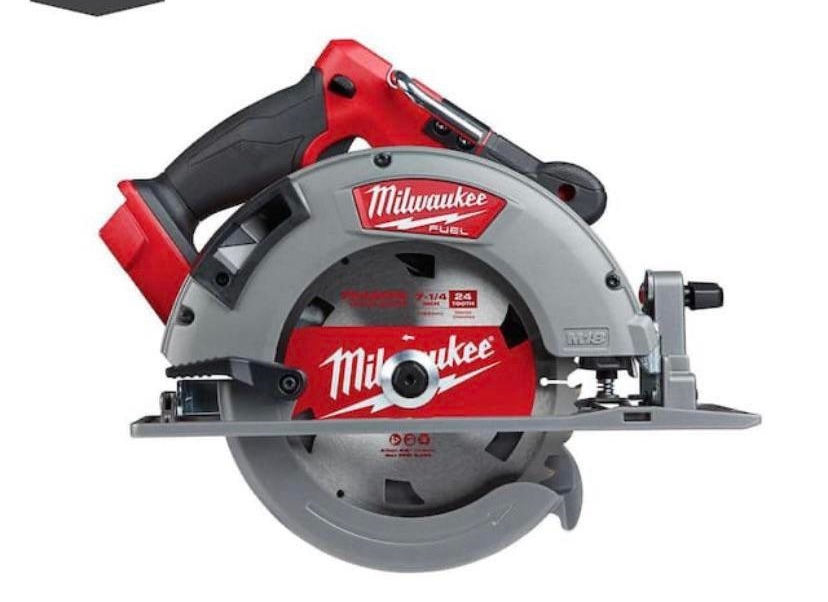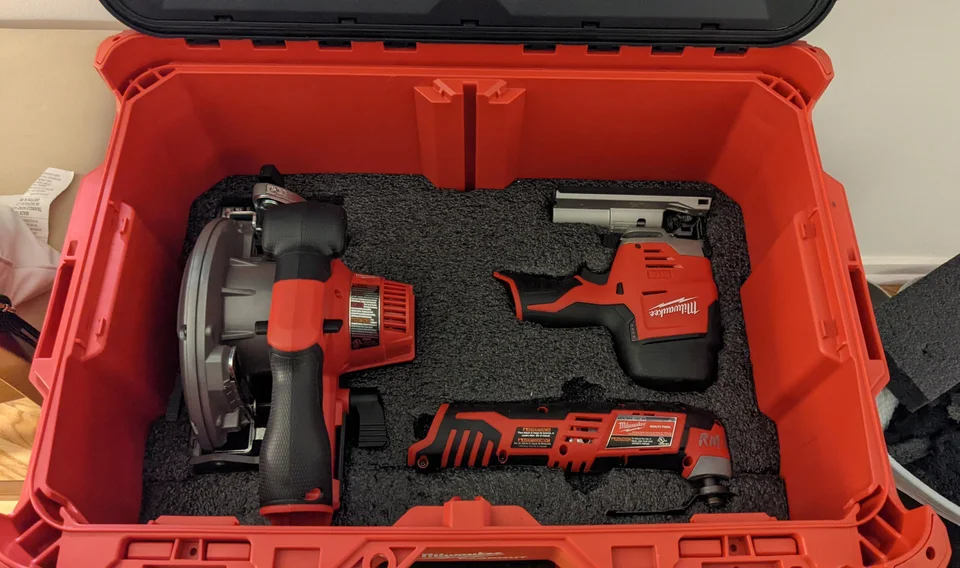Many people who want to buy a circular saw run into the dilemma of whether or not they should get a regular drive or a worm drive one.
In this post, we will go over the differences between the two and also identify which is better for individuals based on their specific needs.
If you’re confused about which type of circular saw to get, it can be a good idea to identify your needs first and then choose a circular saw based on those needs.
Quick Summary
In this post, we will go over the differences between the two and also identify which is better for individuals based on their specific needs.
So without further ado, let’s get started.
What is a Worm Drive Circular Saw?
A worm drive circular saw operates in fairly the same way as any regular circular saw does. The key difference is the fact that its motor is attached to the rear of the circular saw.
This enables the saw to operate at a very powerful rate thanks to the fact that it can be driven through two gears both set at 90 degrees.
Due to this arrangement, the engine of the motor tends to produce more torque but less RPM (Rotations Per Minute). The RPM of a typical worm drive circular saw is usually 4500.
The fact that the motor is at the rear enables this type of saw to be much longer than a regular circular saw. However, that also means that it is typically bulkier and heavier.
What is a Typical Circular Saw?
A typical circular saw has the motor mounted to its side. The fact that the motor is mounted to the side means that it can be driven directly without the use of extra gears.
This is the reason why typical side-mounted circular saws are also referred to as direct-drive saws.
Since the motor is directly driven, the saw blade can reach much higher speeds compared to worm drive circular saws. Direct-drive saws can reach speeds of 6000 RPM.
What are Some More Key Differences Between Worm Drive Circular Saws and Direct-Drive Circular Saws?
We’ve already discussed how the main difference between the two saws is the positioning of the motor. For the former, it’s attached to the rear while for the latter, it’s attached to the side.
However, in addition to that, there are also many other major differences between the two types of saws.
These differences are:
The Orientation of the Saw Blade
Usually, direct-drive saws have the blade positioned to the right side. They are known to be blade-right.
On the other hand, worm drive circular saws usually have the blade positioned to the left side. They are known to be blade-left.
While this may not seem like too big of a difference but the fact of the matter is that this plays a huge role in the slice-line visibility during cutting.
Individuals who are left-handed usually prefer worm drive circular saws. This is because it’s much easier for them to have a clear sight of the slice-line when they are cutting with these saws. Of course, this enables them to make cuts that are much more accurate and precise.
On the other hand, right-handed users prefer direct-drive circular saws since they are able to get much better slice-line visibility when using those saws.
Hence, you must always think about which hand of yours is more dominant when you are trying to decide what type of circular saw to get.
You don’t want to be stuck with the wrong type of circular saw that obscures your vision of the slice-line during cutting.
Rotations Per Minute (RPM)
As mentioned above, when it comes to the Rotations Per Minute (RPM), direct-drive saws have a decent advantage over worm drive circular saws.
Worm drive circular saws typically have an RPM of around 4500. On the other hand, direct-drive circular saws usually have an RPM of around 6000.
You may think that this makes direct-drive circular saws the clear winner in terms of cutting capabilities but that is not entirely true.
This is because this disparity in Rotations Per Minute (RPM) is balanced out when you look at the torque…
Torque
Worm drive circular saws produce a lot more torque during cutting as compared to direct-drive saws.
In layman’s terms, this means that worm drive circular saws are a lot more durable and can output a higher amount of force as compared to direct-drive circular saws.
This makes worm drive saws much more suitable for ripping hardwood and other harder materials.
Worm-drive circular saws can handle loads that would involve higher shocks during cutting. They have a higher loading capacity than regular circular saws and they can easily handle much tougher projects.
Regular circular saws are much smaller and more portable. Hence, they are typically used for softer woods and smaller boards. They are the ideal saw if you want to perform cross-cutting. However, if you want to rip harder materials, then they may not be suitable to use.
Most professionals that own both types of saws usually use direct-drive saws for cross-cutting and worm-drive saws for ripping.
Weight
As briefly mentioned above, direct-drive saws are much more lightweight and portable compared to worm drive saws.
Thus, they are the preferable type of circular saw to get if you tend to move around with your saw a lot. If your work involves you carrying your saw around to different job sites, then it’s definitely the ideal choice.
Direct-drive saws also work well in cramped spaces. Hence, if you have a small workspace, then it’s definitely the type of saw you should consider. They are also much easier to maneuver if you are attempting to make uncommon or complex cuts.
Worm drive saws are much heavier and bulkier. Thus, they are definitely not the ideal option to get if you tend to move around a lot. They are meant to sit at one stationary workspace.
However, their heavier weight is due to the fact that they can handle much tougher materials and projects with ease. They also give you a major advantage when cutting these tougher materials in a descending manner.
Hence, you really need to take into account what your needs are in order to truly determine which type of saw would be best for you.
Do you move around with your saw a lot or do you typically work at one workspace? Also, what type of materials do you work with?
The answers to these questions will help you get one step closer to identifying the most suitable type of circular saw for your needs.
Size
As mentioned briefly above, worm drive circular saws are much bigger and bulkier than direct-drive saws.
Hence, worm drive saws are definitely something you should avoid if you have a smaller or cramped workspace. Not only will you have a hard time fitting them into your workspace but they will also be very difficult to maneuver.
In this case, you’d be much better off with a direct-drive saw.
Only go for worm drive saws if you have the appropriate space to properly use them.
Looking for more resource guides? We’ve got them right HERE.
What are the Advantages of Worm Drive Saws?
As you know by now, the motor of worm drive saws is positioned at the rear of the blade. This makes the centerline of the motor directly parallel to the plane of the saw blade.
This enables the worm drive saw to have a much narrower profile as compared to most other saws. Thus, it enables the saw to get into much more confined spaces for cutting.
Furthermore, the longer distance between the saw handle and the saw blade allows you to extend your reach by a significant amount. Thus, lengthening the cut that you can make on a piece of wood or sheet of material.
This is especially useful when you are cutting sheet metal or other sheet materials.
A worm drive saw also typically has much larger gear teeth with a higher load-bearing capacity compared to most direct-drive saws. This allows them to be a lot more powerful than direct-drive saws so they can handle much tougher materials.
What are the Disadvantages of Worm Drive Saws?
As you may have gathered already, worm drive saws are not exactly portable.
They are fairly bulky, weighing in at around 13 to 15 pounds. This makes them a nuisance to carry around and they are usually only meant to be used in one primary workspace.
While the narrower profile does extend the reach of the saw, it ends up giving the user less control. This is fairly unsuitable for less experienced users and we highly recommend that you stay away from worm drive saws if you are new to woodworking.
Lastly, they are also typically more expensive than direct-drive saws. You can get a high-quality, professional-grade worm drive saw for between $150 to $200.

What are the Advantages of Direct-Drive Saws?
As we know, the motor is positioned to the side of the saw blade when it comes to direct-drive saws.
While this does shorten the reach of the user, it ends up providing more control to them. This can be especially useful if you are creating more intricate or complex cuts. Furthermore, it’s much more useful to beginners and newcomers as well.
Furthermore, direct-drive saws are a lot more lightweight and portable than worm drive saws. This makes them ideal for projects that are less demanding and/or repetitive.
A typical direct-drive saw weighs around 9 to 10 pounds.
Direct-drive saws are also usually cheaper than worm drive saws. You can get a high-quality, professional-grade direct-drive saw for between $125 and $150.
What are the Disadvantages of Direct-Drive Saws?
The most obvious disadvantage of direct-drive saws is the fact that they cannot be used to cut down tougher materials.
You can definitely utilize them for ripping tougher materials if you want but there’s a high chance of tear-out if you do so. Not only that but you’ll also run the risk of damaging the saw blade.
In addition to that, since the motor is on the side of the saw blade, this makes for a bulkier profile as compared to a worm-drive saw. This tends to shorten the reach of the user during cutting.
They are definitely not the ideal choice if you are typically working with tougher materials such as hardwoods and sheet metal.
Wrapping Things Up…
This brings us to the conclusion of our post regarding the intricacies of a worm drive saw.
We hope you now have a better understanding of what a worm drive saw is and how it works.
People often ask us which one’s better: the worm drive saw or the direct-drive saw? The fact of the matter is that neither is better than the other.
Both types of circular saws are used for different purposes and when you use them for those specific purposes, both of them work great.
It’s all about finding the right tool for the job.
If you have any confusion or further questions, please let us know in the comments below.
CLICK HERE, for tool reviews and more.

